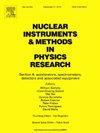A novel anti-aging TBS MRPC for CBM-TOF
IF 1.4
3区 物理与天体物理
Q3 INSTRUMENTS & INSTRUMENTATION
Nuclear Instruments & Methods in Physics Research Section A-accelerators Spectrometers Detectors and Associated Equipment
Pub Date : 2025-06-25
DOI:10.1016/j.nima.2025.170668
引用次数: 0
Abstract
The Compressed Baryonic Matter (CBM) experiment at the Facility for Antiproton and Ion Research (FAIR) aims to investigate the QCD phase diagram in high baryon density regions. Its Time-of-Flight (TOF) system, responsible for hadron identification, uses Multi-gap Resistive Plate Chambers (MRPCs), which are subjected to flux rates as high as 25 kHz/cm in specific regions. Under such conditions, traditional MRPCs with fishline spacers show aging effects, including increased dark current, noise, and performance degradation caused by gas ionization and deposit formation near the spacers.
This paper introduces a novel MRPC design that employs cylindrical thermal bonding spacers (TBS) instead of fishline spacers to mitigate aging effects. The TBS MRPC was produced and tested under cosmic ray conditions and X-ray irradiation. Comparative testing between the TBS and fishline MRPCs showed a notable reduction in current accumulation and stable noise levels for the TBS design. The detector achieved an efficiency of (97.30 ± 0.20)% and a time resolution of (64.54 ± 0.10) ps, satisfying the requirements of the CBM-TOF system. These results suggest that the TBS MRPC is a suitable candidate for high-rate operation in future CBM experiments.
CBM-TOF抗衰老新型TBS MRPC
反质子和离子研究中心(FAIR)的压缩重子物质(CBM)实验旨在研究重子高密度区域的QCD相图。它的飞行时间(TOF)系统负责强子识别,使用多间隙电阻板室(mrpc),其在特定区域的通量率高达25 kHz/cm2。在这种条件下,带有鱼线隔离剂的传统mrpc会出现老化效应,包括暗电流增加、噪音增加、隔离剂附近气体电离和沉积物形成导致的性能下降。本文介绍了一种新型的MRPC设计,该设计采用圆柱形热粘合垫片(TBS)代替鱼线垫片来减轻老化影响。TBS MRPC是在宇宙射线和x射线照射条件下生产和测试的。TBS和鱼线MRPCs之间的对比测试表明,TBS设计显著减少了电流积累和稳定的噪声水平。该检测器的效率为(97.30±0.20)%,时间分辨率为(64.54±0.10)ps,满足CBM-TOF系统的要求。这些结果表明,TBS MRPC是未来CBM实验中高速率操作的合适候选者。
本文章由计算机程序翻译,如有差异,请以英文原文为准。
求助全文
约1分钟内获得全文
求助全文
来源期刊
CiteScore
3.20
自引率
21.40%
发文量
787
审稿时长
1 months
期刊介绍:
Section A of Nuclear Instruments and Methods in Physics Research publishes papers on design, manufacturing and performance of scientific instruments with an emphasis on large scale facilities. This includes the development of particle accelerators, ion sources, beam transport systems and target arrangements as well as the use of secondary phenomena such as synchrotron radiation and free electron lasers. It also includes all types of instrumentation for the detection and spectrometry of radiations from high energy processes and nuclear decays, as well as instrumentation for experiments at nuclear reactors. Specialized electronics for nuclear and other types of spectrometry as well as computerization of measurements and control systems in this area also find their place in the A section.
Theoretical as well as experimental papers are accepted.

 求助内容:
求助内容: 应助结果提醒方式:
应助结果提醒方式:


